A Once Powerful Italian City Still Has Glimpses of Its Storied Past
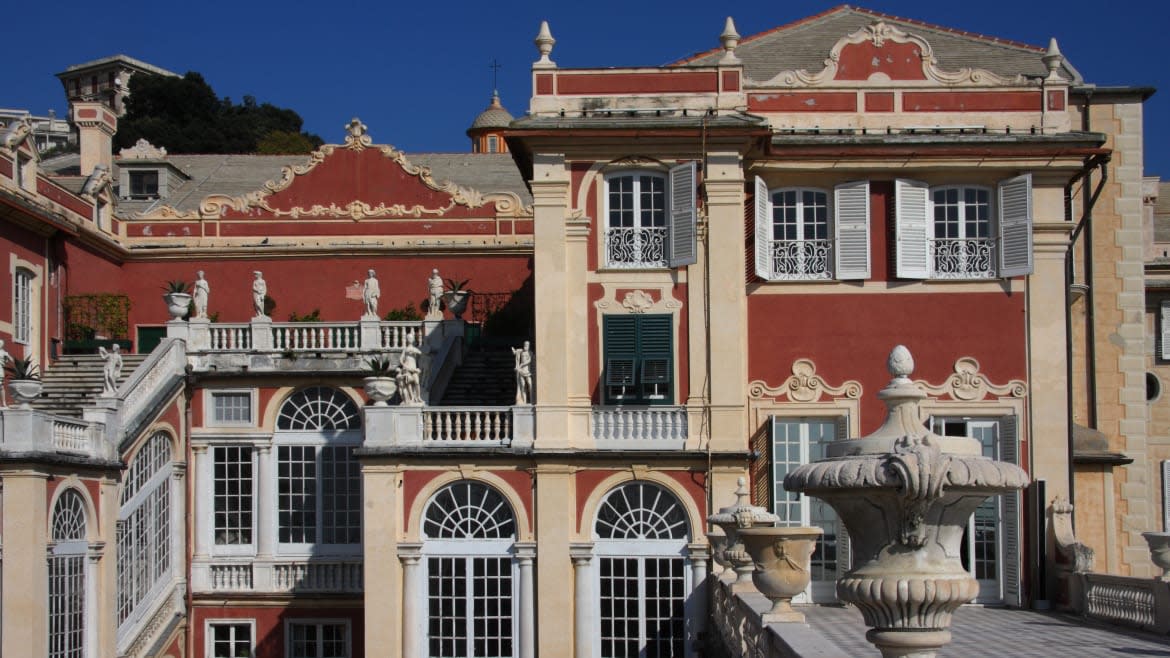
- Oops!Something went wrong.Please try again later.
- Oops!Something went wrong.Please try again later.
- Oops!Something went wrong.Please try again later.
The ossified museum city is a familiar vision—Italy contains several of these sepulchers—and no discredit to them but if you'd like a wealth of history in a living place, try Genoa, a comprehensively engrossing destination overshadowed by many others.
Genoa carried on a centuries-long mercantile rivalry with Venice and yet has certainly lost the game in the larger historical imagination. There are dozens of popular histories on Venice but basically one on Genoa; Venice is one of the 10 most visited cities in Europe, Genoa is … not. And yet the city is fantastic, filled with rich layers of history piled together in the labyrinthine jumble of its città antica, one of the largest medieval centers remaining in Europe.
Genoa remains the second-busiest freight port in Italy, with a largely industrial waterfront teeming with container ships and numerous cruise docks. The city center is also no Airbnb and second home desert but a densely inhabited place. It is a gritty port city in part but it's also dotted with palazzi of absurd extravagance. The city clambers up steep hillsides on all sides in wonderful baroque, art nouveau, and modern layers, with brilliant views obtained with even the mildest gain in elevation. There are no canals, but I don't think you need them. Petrarch called it La Superba and we can’t argue. And I haven’t even mentioned the food.
Twain wrote about the city in Innocents Abroad, that its:
“streets generally are four or five to eight feet wide and as crooked as a corkscrew. You go along one of these gloomy cracks, and look up and behold the sky like a mere ribbon of light, far above your head, where the tops of the tall houses on either side of the street bend almost together. You feel as if you were at the bottom of some tremendous abyss, with all the world far above you. You wind in and out and here and there, in the most mysterious way, and have no more idea of the points of the compass than if you were a blind man.”
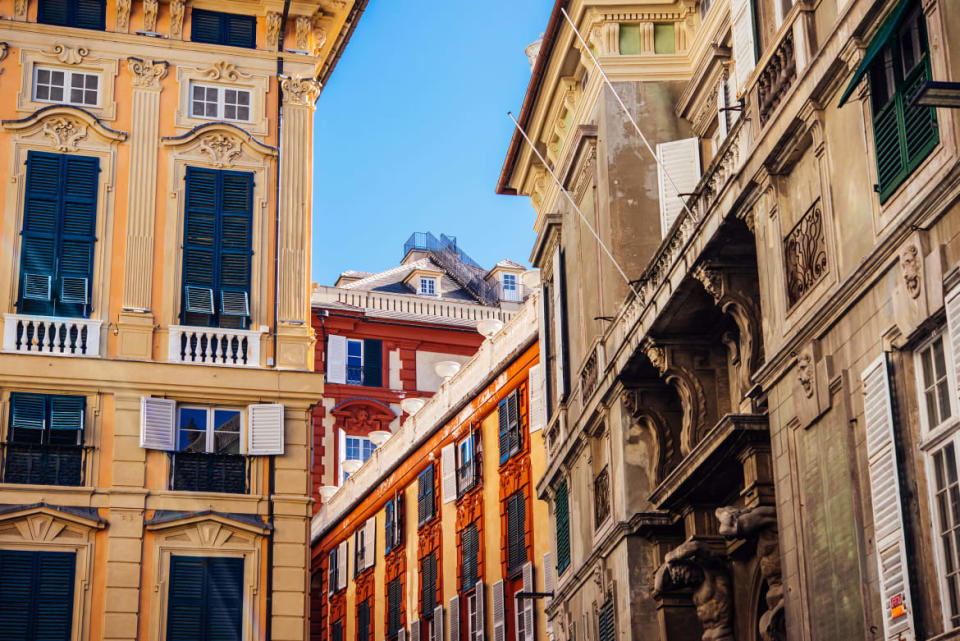
View of old buildings in the historical center of Genoa, Italy.
It is a jumble, and you will get lost—neither Gmaps or a physical map will prevent you taking numerous mildly wrong turns—but isn't that good these days? The historic is surprisingly large by most standards, this is not one of those medieval cores that actually takes five minutes to cross. It contains everything, the Dolce & Gabbana and the washing machine repair shop.
Portions of the city are actively frowsy; prostitution is obvious in portions, and some of the street purchases I witnessed can’t have been welcome to the carabinieri. Perhaps keep your wits about you close to the waterfront after dark; otherwise it seems you needn’t bother.
What remains in the city center is an absurd concentration of palazzi. Its 42 historic Palazzi dei Rolli constitute a UNESCO World Heritage site, and these are just the cream of the crop. You won't notice much of a falloff in the palazzi that didn’t make the cut. They’re visions of grandeur dotted throughout very very narrow streets.
Several of these palazzi are museums and are essential to visit, enormous homes in which every interior chamber seems to bear more gilded than is humanly possible. Twain wrote: "The huge palaces of Genoa are each supposed to be occupied by one family, but they could accommodate a hundred, I should think."
Genoa’s prime centuries as a maritime republic, when its outposts reached as far as the Black Sea, stretched from about the 11th to 15th centuries but it chased this with another immensely possible century plus as main banker to the Spanish Empire. This made for over 600 years of piling up tons of lire (which it has continued to do through finance and shipping since). There aren’t quite so many relics of the East as there are in Venice; Genoa propped up the Byzantine Empire instead of plundering it. Most of its peak finery dates from its days bankrolling Charles V, Philip II, and the like.
The palazzi reflected the networks of Habsburg power in surprising ways; connections to other Spanish possessions were robust. Genoan notables clustered in Madrid and bought Neapolitan fiefdoms. Flemish artists were attracted to the city: Rubens and Van Dyck both spent repeat intervals there and multiple palazzi feature their work (Rubens’ sole book is The Palaces of Genoa). Native sons were often in the service of Spain—Christopher Columbus, Andrea Doria, the general Ambrogio Spinola. Rubens has a painting of a Genoese noblewoman in the National Gallery in D.C., there's a Van Dyck of another at the Getty, more are spread across the globe. Monaco, oddly enough, is the last vestige of the Genoan domain, still ruled by the Grimaldis, a noble Genoan house.
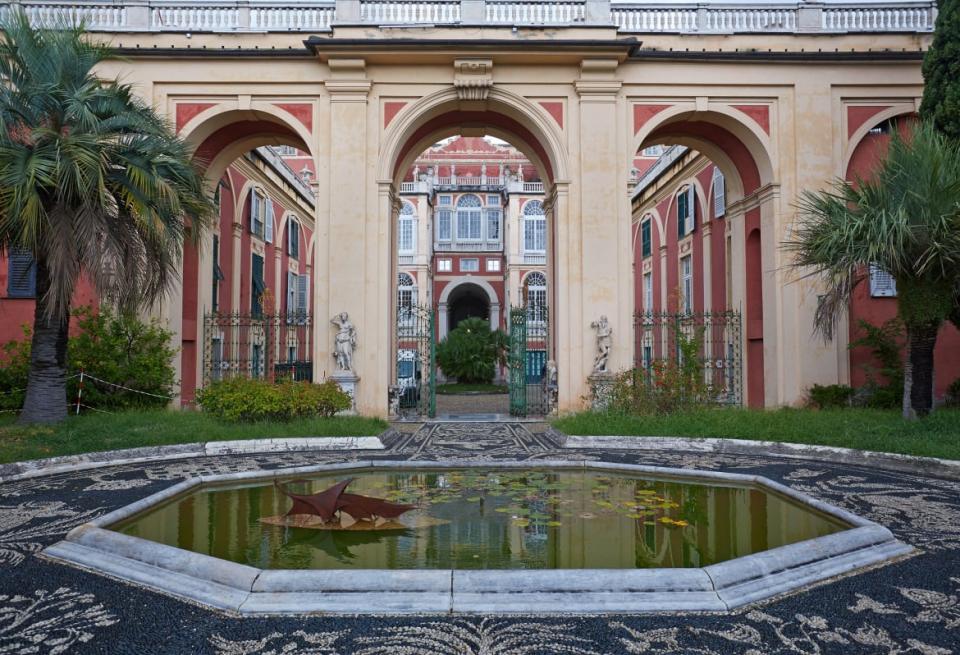
Courtyard and pool of the Palazzo Reale royal palace in Genoa.
The Palazzo Reale, a building that was royal only later, after the Republic's absorption by the Duchy of Savoy, is one of immense pomp surrounding a central courtyard constructed over much of the 17th century. Frescoes will enchant. There’s Valerio Catello’s Allegory of Fame, with a winged trumpeter proclaiming the glory of the family in especially knavish trompe lóeil composition, opening the roof to an ever-sparkling sky. Or Domenico Parodi's Triumph of Bacchus (fun!) in the palace’s Hall of Mirrors. The collection features pieces by Bernardo Strozzi, a top-tier native son fusing Carravagist and Flemish influence, Il Grechetto, whose shadow-laden oil sketches are excellent, a Tintoretto, a Luca Giordano, and a number of Van Dyck paintings.
When inside I experienced my first perceptible earthquake (terremoto was a vocabulary acquisition I didn’t think I'd be making). Hopefully you won't!
The Via Garibaldi, originally the Strada Nuovo, is the showcase avenue for Genoan wealth, lined with sumptuous palazzi—broad by Genoan standards it’s still narrower than most two-lane streets in the US.
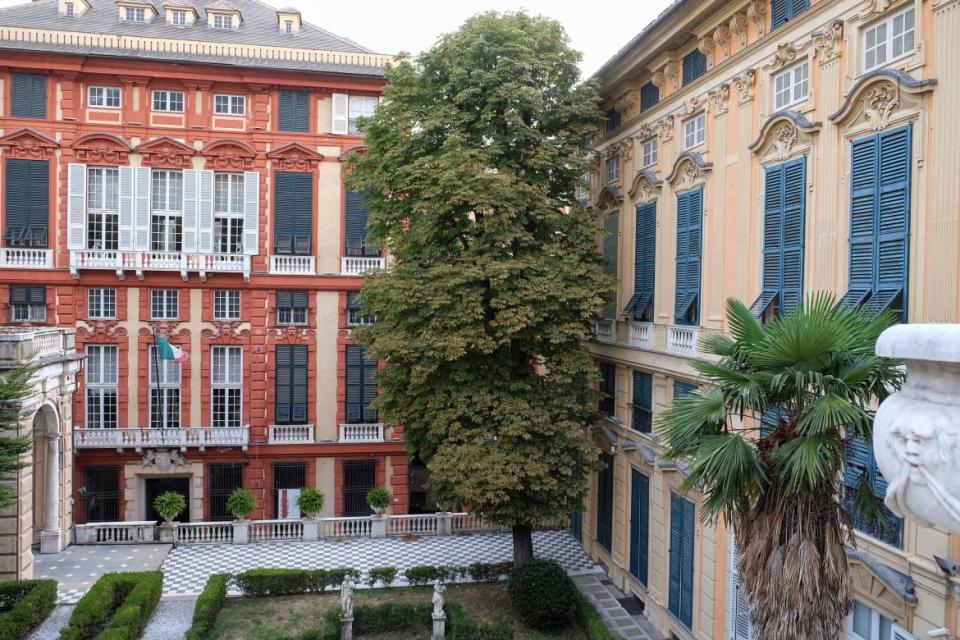
The historical palace Palazzo Rosso and the galleries of Palazzo Bianco.
The Palazzo Rosso is the most impressive museum on the strada. It was built for the Grimaldis and then passed on to other grand families, much of the interior reflects a 1714-16 renovation. You will find yourself ecstatically en-frescoed; resist the desire to lie on the floor. Gregorio de Ferrari and Domenico Parodi’s Four Seasons frescoes are rapturous. Trompe l’oeil is consistently on overdrive on nearly all ceilings; Lorenzo di Ferrari’s scenes of Roman epic tales in the Salon of Virtu Patrie are another standout.
The art is splendid, with multiple Van Dycks and Il Grechettos, a Durer, and a Veronese.
Edith Wharton once wrote that “Genoa, one of the most splendour-loving cities in Italy, had almost always to import her splendour.” Now it doesn't serve anyone well to disagree with Wharton much but she undersells local talent that tends to be fundamentally overlooked (if Genoa had no qualms about buying splendor from anyone who would sell it). It didn’t have a Venice-quality Titian-Tintoretto-Tiepolo-Canaletto-Guardi heyday—nowhere else really did either—but boasts a fantastic store of art that's largely unknown.
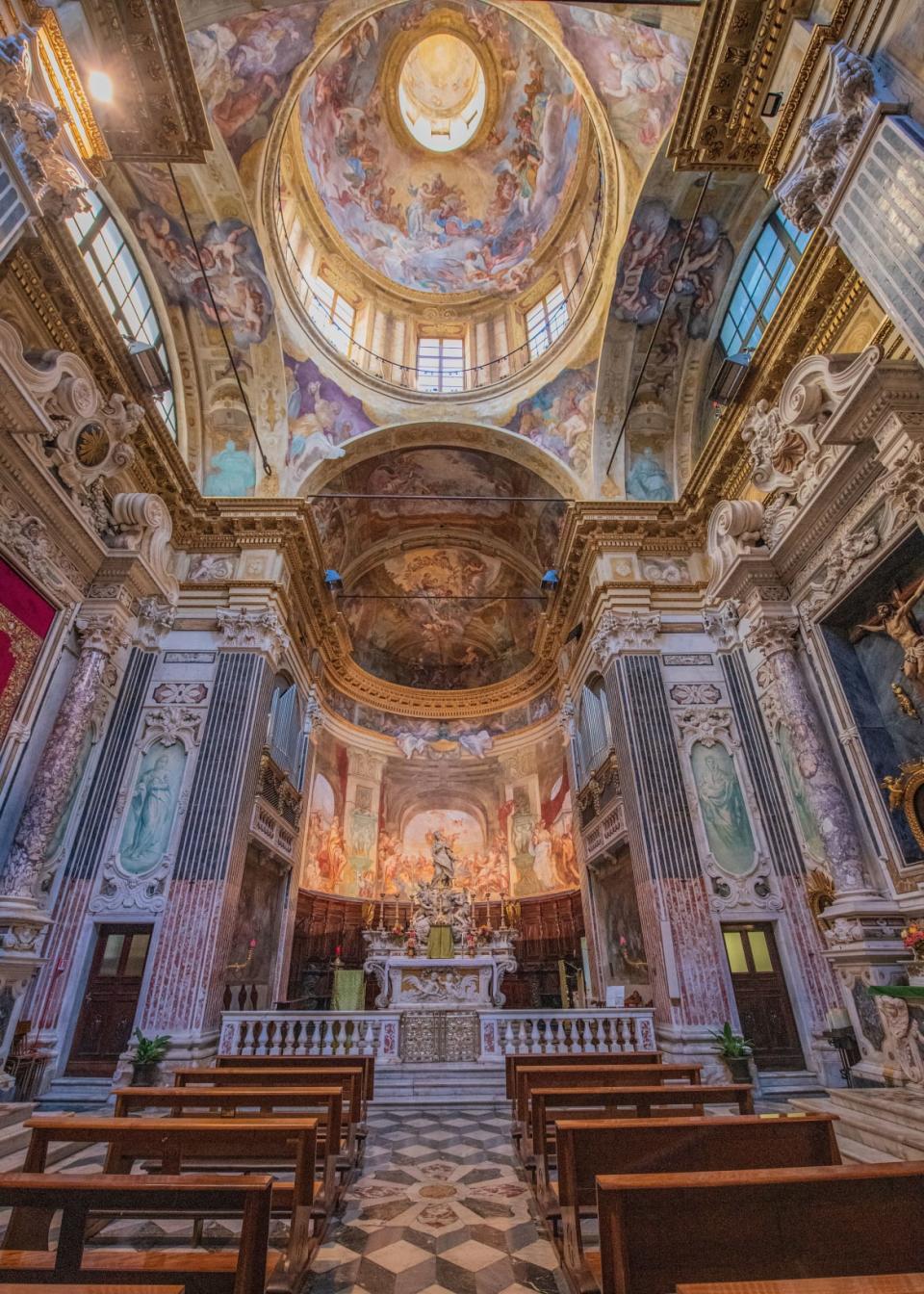
Inside the Church of San Luca
Gregorio De Ferrari is one of their stunning artists you’ve probably missed, found in the Palazzo Rosso and elsewhere in the city. Piero Boccardo and Franco Boggero, curators for A Superb Baroque: Art in Genoa 1600-1750, a 2021 exhibition scuttled by COVID, wrote in the catalog: “Whether in a drawing, fresco, or canvas, De Ferrari’s style is unmistakable–free flowing, exploratory, and such an anticipation of the rococo that one critic deemed him a grander Fragonard,” even though Fragonard was born after the Genoese painter died.
There are a number of surprises on its upper floors. There’s a low-ceilinged mezzanine apartment, a traditional servant haunt, where one aristocrat chose to live, and commissioned frescoes by Domenico Parodi, providing something of the aura of luxe cave paintings.
There’s also an apartment designed by modernist architect Franco Albini for Caterina Marcenaro, a former director of the Museums of Genoa, which intermingled high Dolce Vita-era modernism with older elements.
The Palazzo Biano is more of a straight-up art gallery and contains another great collection. There's a wonderful Caravaggio Ecce Homo. You get some of everything good. More Veronese, Rubens, and Van Dyck. There’s a Luca Cambiaso (who painted frescoes in the Escorial for Philip II), Renaissance Florentine Filippino Lippi, and multiple Spaniards: Murillo, Ribera, and Zurbaran. A highlight are pieces by Alessandro Magnasco, a difficult-to-classify late Genoan genius.
Peer into other palazzi entrances along the Via Garibaldi, you can stroll into a few. The Palazzo Doria Tursi contains an awesome courtyard and several rooms dedicated to native son Paganini.
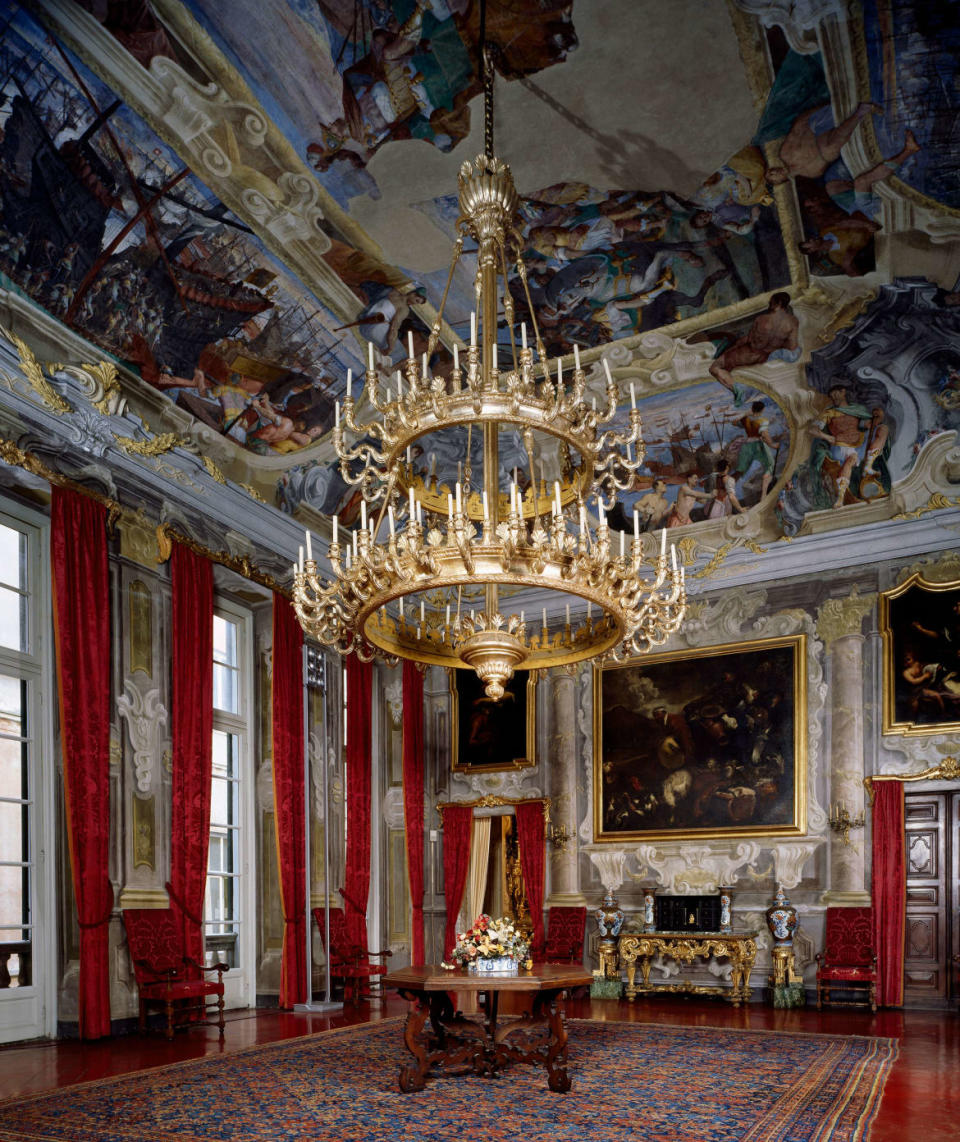
Reception room with frescoes by Lazzaro Tavarone (1556-1641) on the second floor of Palazzo Spinola.
Palazzo Spinola is also tremendous, found a bit south via another wandering route. It was originally owned by the Grimaldis of Monaco fame, passing through a rotation of Genoan high-hats to the Spinolas There are excellent frescoes by Lorenzo De Ferrari, and Lazzaro Tavarone. Its Gallery of Mirrors is one of the grandest spaces in town.
Genoan top floors have suffered repeat tragedies due to the tendency of foes to bombard the city; Louis XIV in 1684 (which at least paved the way for new frescoes), and well, us, among others in World War II, due to the dual Italian misfortunes of placing a working port next to their old city and having Mussolini as their leader. Many top floors haven’t quite been refurbished; this one contains an art collection spanning a broader range. There’s a Rubens-like vast Allegory of Peace and War by Neopolitan Luca Giordano, more de Ferrari, an equestrian portrait by Rubens, a Tintoretto that Mussolini once gave to Hitler, and more Van Dyck.
A little ways west there’s a palazzo of a distinctly earlier stamp, the Palazzo Doria, built for that admiral, on a site that’s extremely emblematic of contemporary Genoa: a renaissance villa and garden overlooking an elevated highway and a cruise ship terminal.

In the Palazzo Doria
There’s pre-trompe l'oeil work here, especially a wonderful horizontal fresco by Perin del Vaga, a student of Raphael, who draws on themes from Ovid, and more mythology otherwise than I can follow. There are other segmented frescoes of a distinctly earlier stamp, which look a bit like hanging your ceiling postage stamp style. Not to mention numerous Piola paintings and a magnificent set of tapestries depicting the battle of Lepanto designed by Luca Cambiaso and Lazzaro Calvi (and woven in Flanders) commissioned by Doria's nephew.
Just rambling around is a principal joy, do that as often as possible. You’ll find local fare of a character you won’t find in most locations. The focaccia is the obverse of the thick doughy trash you’ll usually find stateside; thin, crisp, and laden with olive oil and salt, topped with olives, potatoes, cheese. The locals dunk it in espresso; do what you will. Farinata, a chickpea bread, is dramatically better than it might sound. There are all sorts of cheese and vegetable tarts with thin layers of dough. I've never eaten any fish but you should. It’s also the home of pesto, so refuse no chance for a dollop ever.
The ancient port is worth a stop; it feels somewhat familiar so far as these sort of things go, but an inner harbor designed by native son Renzo Piano couldn’t be bad. The aquarium’s exterior is very fine, I assume the same of the fish. The Maritime Museum contains a range of relics of the city’s salty past. There’s a reconstructed galley and all sorts of content from its golden era, as well as exhibits on immigration, the Andrea Doria (the liner, RIP and more. I have a limited appreciation for sextants but there’s much else to keep you interested.
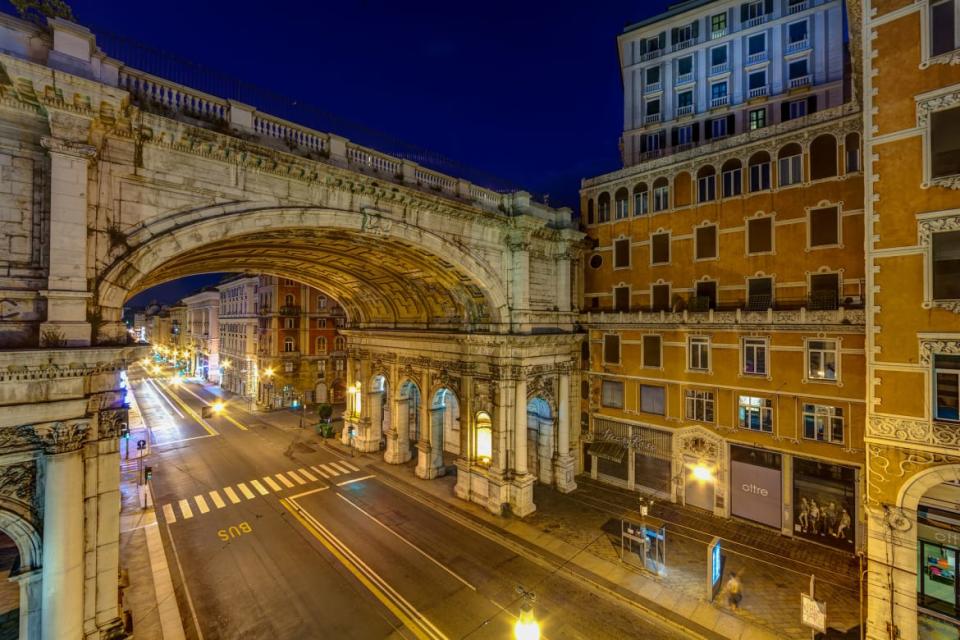
Shopping street Via XX Settembre with Ponte Monumentale at night
The city is fascinating as it swells out around surrounding hillsides. There’s a real resemblance to Rio de Janeiro in the manner in which a modern city was threaded through very steep hills; some buildings fully surround tunnels, there are vertiginous feats everywhere. Take a look at the Teatro Carlo Reggio, rebuilt by Aldo Rossi. Via XX Settembre is a grand showcase of later architecture and shopping. There's a great early modernist Terrazza Martini Tower by Marcello Piacentini. The Centro dei Liguri near the Baltimore gardens is something for the brutalist freaks.
You must ascend hills; take the free Zecca–Righi funicular or get some exercise anywhere. Stop at the Giardini Tito Rossino. Art Nouveau villas (the most striking by architect Gino Coppedè) line the streets of the Castelletto neighborhood along its route. You'll walk off any amount of focaccia quickly along those switchbacks. The Casa D’Albertis is an 1890s Gothic Revival fairytale castle hosting an assortment of world art and artifacts—why not?

Castello D'Albertis
If you want a stately encounter with the sea you ironically won’t get all that much of it in town because of all the working port elements–but you can get it by venturing east. The suburb of Albergo features wonderful views, as does the old seaside village of Boccadese. If a day just sunning yourself in a seaside village seems a frivolity when you’re near so much wonderful history you can combine both nearby in Nervi, a place to get a breath of air and stroll along the seashore while not falling behind on culture.
Genoa clustered much of its more recent art here in three smaller museums the Frugone Collection, the Genoa Gallery of Modern Art, and Genoa's branch of the Wolfsonian. The Frugone is a collection of two brothers, spanning the 1850s to early 1920s. You'll find superb Italian impressionism and Barbizon school offshoots, high points being Giacomo Favretto, Giovanni Boldini, Giuseppe Di Nittis, Mose Bianchi. A park stoll away is the Genoa Gallery of Modern Art, a collection begun with a donation from a son of King Vittorio Emmanuele in 1866. There's a broad range of great items, artists from Nicolo Barbarino to Tammar Luxoro to Alberto Issell, symbolists you've never heard of and some early modernists.
The rough chronological sequence of art continues in Genoa’s branch of the Wolfsonian, which features an excellent assortment of Futurist and Art Deco art and furniture. There are Italian stars such as Prampolini, Dottori, Depero, and Crali and International modernists Dali, Delaunay, and Léger. Furnishings by Duilio Cambelotti and Alciabide Mariotti are as swank as can be.
After some air in Nervi there was something actively comforting about a return to the old city. You don’t have to take my word for it; I’ll leave you with Henry James:
“Genoa, as I have hinted, is the crookedest and most incoherent of cities; tossed about on the sides and crests of a dozen hills, it is seamed with gullies and ravines that bristle with those innumerable palaces for which we have heard from our earliest years that the place is celebrated. These great structures, with their mottled and faded complexions, lift their big ornamental cornices to a tremendous height in the air, where, in a certain indescribably forlorn and desolate fashion, overtopping each other, they seem to reflect the twinkle and glitter of the warm Mediterranean.”
Get the Daily Beast's biggest scoops and scandals delivered right to your inbox. Sign up now.
Stay informed and gain unlimited access to the Daily Beast's unmatched reporting. Subscribe now.

